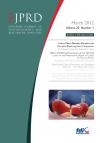European Journal of Prosthodontics and Restorative Dentistry

- Cover Date:
- March 2012
- Print ISSN:
- 0965-7452
- Vol:
- 20
- Issue:
- 1
Book Review
3D Head & Neck Anatomy for Dentistry. Reynolds, P. A. et al. (Eds.) (2008). Primal Pictures: London. ISBN 978-1-904369 -83-7. DVD-ROM £180.00
We all recognise that the students we teach exhibit a range different learning styles meaning that we expect them to respond differentially to material presented to them in different formats. Consequently, this DVD on 3D Head and Neck Anatomy for Dentistry, providing, as it does, another means by which students can learn anatomy, is greatly to be welcomed. The DVD loaded readily onto my computer and proved very easy to use and intuitive to navigate around and has considerable functionality. At the core of the product is a series of 3D diagrammatic reconstructions of the head and neck presented as a series of layers with structures being added progressively as one navigates through these layers. One can zoom in or out of the images, rotate the layers, save or print the images. Another section of the DVD contains a series of MRI images in the axial, coronal and sagittal planes that are accompanied by 3D reconstructions and these can also be manipulated by the user. The MRI images are in a part of the DVD that the authors call the slide section. This section also contains static images of cadaveric prosections, anatomical line diagrams and clinical slides. There are further sections containing movies and animations that illustrate selected muscle actions and movements of the temporomandibular joint. These illustrations are accompanied by a wealth of text describing the anatomy and dental clinical correlations. There are search facilities, a comprehensive help section and an introductory tutorial. The best parts of this DVD are very good indeed. The coverage of skull anatomy and the neck is especially good. The ability to navigate through the layers and rotate the images enables a fuller appreciation of anatomical relationships. Especially useful in this section was the ability when highlighting a structure, to have it named and then to be able to read some text describing its anatomy. However, what was not always easy to follow were the relationships between muscles within a region. This was especially true within the floor of the mouth, obviously an important area of dental anatomy. It would be helpful, when highlighting a structure, to have its relationships explained in the text. The slides illustrating the cadaveric prosections were exceptionally clear and represent a considerable advance on the traditional static atlas format. The ability to obtain the name of a structure by passing the mouse over it is extremely useful. It is disappointing that, in contrast to the 3D reconstructions, highlighting a structure does not also cause the textbox to appear. The other observation to make in relation to the cadaveric slides is that they do not cover the full range of structures visible in the head and neck, again a notable omission being within the floor of the mouth. The MRI images are very useful to have alongside the anatomical reconstructions; perhaps a future edition would also consider adding cone beam tomographic images as their use in dental diagnostics is increasing. One particular difficulty with this DVD which presents a problem when using it in undergraduate teaching is the extraordinary level of detail. I appreciate the dilemma of the authors here in wanting to present a product that will be of use to a range of professionals including teachers. However, the level of detail could easily overwhelm the average undergraduate and it would be important to use this DVD selectively for students beginning to learn anatomy rather than relying on it as a primary source. In summary, this is a very attractive product that can be recommended to dental professionals, dental teachers, students on postgraduate courses and, with appropriate support, to undergraduate students. This review originally appeared in the British Dental Journal (Volume 206) and is reproduced here with kind permission from the Editor-in-Chief. Pr ofessor S McHanwell School of Dental Sciences Newcastle University
10
- Article Price
- £15.00
- Institution Article Price
- £
- Page Start
- 10
- Page End
- 10
- Authors
- S. McHanwell
Articles from this issue
- Title
- Pg. Start
- Pg. End
- Effect of Welding Parameters of the Nd:YAG Laser on the Penetration Depth of Cobalt Chromium Alloys
- 11
- 16
- Accuracy of Shade Matching Performed by Colour Blind and Normal Dental Students Using 3D Master and Vita Lumin Shade Guides
- 23
- 25
- Correlation between Dental arch location and Clinical Success Rate of Total etch and Self-Etch Adhesives in Class V Composite Restorations
- 26
- 30
- Trends in Material Choice for Direct Restorations by Final Year Students from University College Cork 2004-2009
- 31
- 34
- Effects of Different Pretreatments on the Bond Strength of a Dual-Cure Resin Core Material to Various Fiber-Reinforced Composite Posts
- 41
- 47
